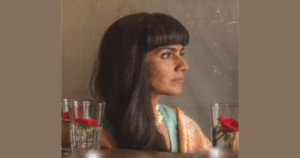Say the name ‘Mary Quant’ and an image of a young brooding woman comes into your head – she is peering through a fringe at you and sporting a bob haircut. She came of age as colour magazines boomed and provided some of the key images that represented that new sixties phenomenon – the teenager.
How did Mary Quant become ‘Mary Quant’?
Partly, it was about timing – after the austerity of the fifties, a younger generation was emerging that had disposable income to spend on fashion, music, haircuts, going out and magazines packed with exciting colourful images. Youth culture was born. Young women were liberated by the pill and could choose to have partners before marriage without fear of the devastating consequences of an unwanted pregnancy.
Into this culture, Mary Quant dropped a perfectly timed bombshell – the miniskirt. It is easy to forget just how revolutionary this was. Until then, young women dressed like their mothers – long, full skirts with cinched waists. The miniskirt was, however, shockingly short and worn by famous models like Twiggy. Your mum would never wear it and many young women went out in the evening with their parents’ words ringing in their ears: “Surely, you are not going out dressed like that!!!” Respectable it wasn’t and that was the point. When Quant was awarded an OBE for fashion in 1966, she went to meet the Queen dressed in a mini skirt, which was, of course, great publicity and slightly shocking.
Quant then was responsible for one of the great fashion innovations – a symbol of re-evaluation – that signalled a permanent shift in culture. And she parlayed her new look into a global fashion empire. An instinctive marketer, she understood something else important. Young people had disposable income for the first time but they did not have much. The clothes were inexpensive and well-made. She made new clothes in small batches which meant you had to get them whilst you could, and there was always something new in store. Scarcity and novelty – two staples of successful marketing – fuelled editorial coverage in colour magazines.
She was also in London and a part of different networks that aided her fame. Born of two Welsh school teachers, she married an aristocrat – Alexander Plunket Greene. The aristocracy remained a powerful and useful network in the sixties which intersected with the Chelsea Set – a new form of aristocracy. Her shop on the King’s Road also contained a smart basement restaurant where bright young things – including the Beatles – met and were seen and photographed.
Her stores were fun and colourful, with loud music and striking window displays. A place not just to shop but to party and flirt and meet friends. In this, she prefigured a modern trend – the idea of shopping as entertainment and shops as temples of desire.
Mary Quant was painfully shy in public. But that did not matter – broadcast media like the BBC had yet to really discover youth culture – with the possible exception of Top of the Pops (started in 1964). This was the era of advertising and magazines – of ‘key images’ (think of all those album covers) and no fashion item then was more powerful and transformative in the lives of young women than the miniskirt. To our eyes it may present overly sexualised images of young women. But in the sixties, it was a burst of colourful joy after the long rainy grey days of austerity in Britain in the fifties.
Quant’s timing was perfect – but also, she worked hard with her partners for success through brilliant design, combined with marketing and business flair.
Julian Saunders was CEO, Red Cell advertising (a WPP company). He was also Planning Director, Ogilvy, Executive Planning Director, McCann-Erickson and The Zoo, Google. julians@joinedupcompany.com




Comments (5) Closed